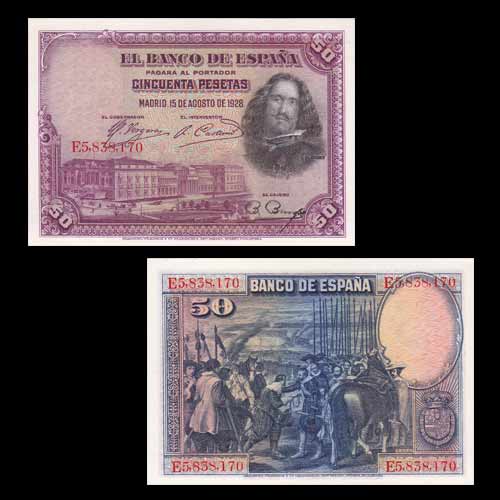History on Banknotes: Part I
2017-12-06 Wed
We have so far just seen our money (banknotes and coins) as legal tenders to be exchanged for availing goods, commodities and services. But have you ever looked at your money as a book, as a source of knowledge and history?We are guessing...No. Well, don’t worry. We will help you gain that vision and give you an insight into a few historical events that were commemorated and immortalised on banknotes!
Today let’s look that a Spanish 50 Pesetas banknote of 1928. The obverse of the note depicts the Prado Museum in Madrid (Museo Nacional del Prado). It also sports portrait of Diego Rodriguez de Silva y Velazquez, a leading artist in the court of King Philip IV. He was one of the most important painters of the Spanish Golden Age and was famous for his numerous renditions of scenes of historical and cultural significance.
Now to the historical part:
The reverse has one of the most notable works of Diego Rodriguez: “The Surrender of Breda”, a rendition of a historical event that took place on June 2, 1625! The Surrender of Breda, also known as El Cuadro de las lanzas or Las lanzas was painted by this great individualistic artist of the contemporary Baroque period during the years 1634–35 on canvas.
The Siege of Breda was one of the major successes of Spanish Army in the latter stages of the Eighty Years' War. Breda was a city near the frontier of Holland occupied in 1567 by the Duke of Alba and later seized by Haultepenne. The Spanish general, Genoese aristocrat Ambrogio Spinola, conquered Breda against the instructions of his superiors.
Diego painted ‘The Surrender of Breda’ as an emblem of Spanish nationalism and as a tribute to Ambrogio Spinola. The painting captures the event that took place on June 2, 1625, when the Dutch governor, Justin de Nassau, delivered the keys of the city, symbolically, to Ambrosio de Spinola.
Interestingly, in 1639, shortly after the canvas was completed, Spain lost the city of Breda forever; it was conquered by Frederick Henry of Orange!
It’s amazing how such events can still be retold through our modern currencies. Stay tuned for more of such historical and cultural insights! Till then...keep visiting!
Latest News
-
Ghiyath Shah as Sultan
2025-10-17 FriAfter ascending the throne of the Malwa Sultanate, Ghiyath Shah issued circular coins early in his r...
-
Malwa Sultan Ghiyath Shah Square Gold Tanka
2025-10-16 ThuMalwa Sultan Ghiyath Shah issued square gold tankas in three weight standards: Double Tanka (21.9g),...
-
Malwa Sultan Ghiyath Shah's Billon Tanka as Heir Apparent
2025-10-14 TueIn Billon, Ghiyath Shah issued coins under two weight standards. Billon Tanka of 96 rati (10.7-11g),...
-
Antiochos I Soter Silver Tetradrachm, weighing 16.87 grams, sold for INR 22,000.
2025-10-07 TueAntiochos I, the Greek king of the Seleucid Empire, was of mixed heritage, being half-Iranian and ha...
-
Ghiyath Shah as Heir Apparent
2025-09-25 ThuGhiyath Shah was the ruler of the Malwa Sultanate, reigning from 1456 to 1500. From 1456 to 1469, he...

